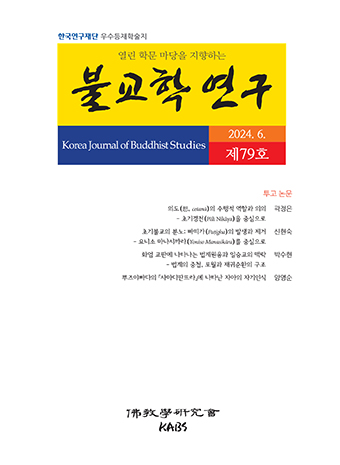Abstract
References
Sorry, not available.
Click the PDF button.
Information
With its starting point Joseon Buddhism Monthly Journal published in 1912, about 20~30 modern Buddhist journals have been created and known. Among them, the long-time published journal with the most stable foundation would be Bulgyo (Buddhism), published from July 1924 to July 1933, with a total 108 volumes. Buddhism was composed of historic, cultural, and literary contents other than ideological discourse, showing the character of a general journal. Following exploration of the previous studies on the literature field of Buddhism in the 1920’s, this study investigated the subject and power of a literature field in the 1930’s. The main targets were representative editors, associated personnel and reporters. They did not only conduct administrational works but acted as the subjects to form a literature field as well. In fact, they played an initiative role in embodying a literature field through creating literary works in reality. This study explores the new section created by Han Yong‐un (Manhae), the editor who put his own poem in the beginning of the journal, adding a character of literature journal, and also the literary men he introduced through the section. During this process, about 40 new poets from monastic schools or professional schools made their debut through the section 'Buddhist Poems'. Han Yong‐un was the center of this change. In addition, former and present reporters including Kim Tae‐heup, Doh Jin‐ho, Kim Il‐yeop, Ahn Jin‐ho, etc., were active in various types of literary fields such as poetry, travelogues, essays, plays, novels and legendary stories, and they expanded the horizons of Buddhist literature. At the end of the 1920’s, their works substituted those of general writers and heralded the tendency of reinforcing religiosity and contemporaneity in literature in the 1930’s
근대 불교 잡지는 1912년에 간행된 조선불교월보를 기점으로 2~30종정도가 전해지는 것으로 알려져 있다. 이들 잡지 가운데 가장 안정적인 기반을 가지고 오랫동안 간행된 잡지는 단연 불교(전108호, 1924.7~1933.7)이다. 불교는 다양한 사상적 담론 외에 역사적 문화적 문학적 내용이 호마다 편제되어 있어 종합지적인 성격을 보여준다. 1920년대 불교지에 구현된 문학장에 대한 선행 고찰에 이어 본고에서는 1930년대의 문학장 구성의 주체와 그 문학적 실현 양상에 대해 살펴보았다. 연구 대상은 대표 편집인과 소속 직원 및 기자들이다. 이들은 단순히 행정적 역할만 한 것이 아니라 이 시기 문학장 구축의 주체로서 자리 잡고 있으며 실제로도 문학 작품 창작을 통해 문학장을 구현하는데 주도적 역할을 하고 있기 때문이다. 본고는 권상로에 이어 편집인으로 등장한 한용운이 새로운 편제를 통해 신진문사들을 다수 등장시킨 경과를 살펴보았고, 권두언에 새로운 산문시를 게재함으로써 문학지의 성격을 가미한 것을 확인하였다. 이렇게 구축한 [불교시단]을 통해 이 시대 새로 약진하는 강원, 전문학교 출신의 문학청년 40여 명이 시인으로 성장할 기회를 갖게 된다. 만해는 이들 신진 문사들, 불교문학청년들을 지면으로 이끌어내는데 좌장 역할을 한 것으로 평가할 수 있다. 이와 함께 김태흡, 도진호, 김일엽, 안진호 등 불교사의 전 현직 직원 및 기자(촉탁기자 포함)들은 시, 시조, 기행문, 수필, 희곡, 설화, 소설 등 다양한 양식을 활용하여 불교문학장을 확장하는데 기여하였다. 이들의 글은 1920년 말의 일반문인의 문학작품을 대체하면서 종교성과 시대성을 강화하는 1930년대 초의 경향성을 보여준다.
Click the PDF button.
- Publisher :Korean Association of Buddhist Studies
- Publisher(Ko) :불교학연구회
- Journal Title :Korea Journal of Buddhist Studies
- Journal Title(Ko) :불교학연구
- Volume : 48
- No :0
- Pages :31~63


 Korea Journal of Buddhist Studies
Korea Journal of Buddhist Studies






